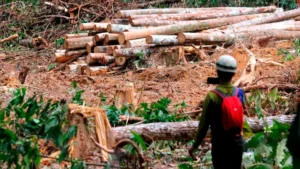How US Federal Programs Support Private Forests
- September 2, 2024
- 0 comment
Private forests in the United States are vital to both the country’s ecological health and economic well-being. Spanning millions of acres, these privately-held lands are essential for conserving biodiversity, sequestering carbon, and sustaining rural economies.

Acknowledging the critical role these forests play, the U.S. federal government has established various programs to support private landowners in implementing sustainable management practices. Exploring the historical background, key federal initiatives, and the challenges and future outlook of these efforts offers a detailed understanding of the U.S. approach to managing private forests.
Federal Programs for Private Forests
Several federal programs have been established to support private forest owners in the United States. These programs offer financial assistance, technical guidance, and other resources to encourage sustainable forest management.
- The Cooperative Forestry Assistance Act: The Cooperative Forestry Assistance Act serves as the foundation for many federal programs targeting private forest owners. This legislation provides a framework for cooperation between federal and state governments, offering financial and technical assistance to private landowners. Through this act, several key programs have been developed, including the Forest Stewardship Program and the Environmental Quality Incentives Program.
The Forest Stewardship Program (FSP)

Origins and Development
The Forest Stewardship Program (FSP) was established under the Cooperative Forestry Assistance Act to provide private forest owners with the tools and resources needed to manage their forests sustainably. The program aims to enhance the environmental, economic, and social benefits of private forests by offering tailored management plans and technical assistance.
- Program Components: FSP offers a range of services to private forest owners, including the development of individualized forest management plans. These plans are created with the assistance of professional foresters and outline specific practices to achieve the owner’s management objectives, whether they are related to timber production, wildlife habitat improvement, or recreation.
- Impact on Private Forest Management: Since its inception, the FSP has had a significant impact on private forest management across the U.S. By providing landowners with access to professional expertise and financial resources, the program has helped to improve forest health, increase timber production, and enhance wildlife habitats. However, the program also faces challenges, such as limited funding and the need to balance multiple land-use objectives.
- Success Stories and Challenges: Numerous success stories highlight the positive impact of the FSP on private forests. For instance, in the Appalachian region, the program has helped landowners restore degraded forestlands and enhance biodiversity. However, challenges remain, including the need for more outreach to underrepresented landowners and the ongoing struggle to secure adequate funding.
The Conservation Reserve Program (CRP)

Purpose and Goals
The Conservation Reserve Program (CRP) is another critical federal initiative aimed at promoting conservation on private lands. Established in 1985, the CRP provides financial incentives to landowners who voluntarily remove environmentally sensitive land from agricultural production and implement conservation practices, including tree planting.
- Enrollment Process: Private forest owners can enroll in the CRP through a competitive bidding process. Once accepted, they receive annual rental payments and cost-sharing assistance for implementing conservation practices. The program emphasizes the restoration of degraded lands, soil erosion control, and wildlife habitat enhancement.
- Benefits to Private Forest Owners: The CRP offers numerous benefits to private forest owners, including financial compensation for land that might otherwise yield low returns from agriculture. Additionally, the program helps to improve environmental quality by reducing soil erosion, enhancing water quality, and providing habitat for wildlife.
- Criticisms and Limitations: Despite its successes, the CRP has faced criticism, particularly regarding its impact on local agricultural economies. Some argue that the program incentivizes the removal of productive land from agriculture, which can have negative economic consequences for rural communities. Additionally, there are concerns about the long-term sustainability of the land enrolled in the program once contracts expire.
Environmental Quality Incentives Program (EQIP)

Overview of EQIP and Its Application to Private Forests
The Environmental Quality Incentives Program (EQIP) is another federal initiative that provides financial and technical assistance to private forest owners. Administered by the Natural Resources Conservation Service (NRCS), EQIP supports the implementation of conservation practices that address environmental concerns, such as soil erosion, water quality, and wildlife habitat.
- Financial and Technical Assistance Provided: Through EQIP, private forest owners can receive financial assistance to cover the cost of implementing approved conservation practices. Additionally, the program offers technical assistance from NRCS staff and other conservation professionals, helping landowners design and implement effective management strategies.
- Case Studies of Successful Implementations: EQIP has been successfully implemented in various regions across the U.S., helping private forest owners address environmental challenges while improving the productivity of their lands. For example, in the Pacific Northwest, EQIP has supported efforts to restore salmon habitat by improving forest management practices and reducing sedimentation in streams.
Federal and State Partnerships

Collaboration between Federal and State Agencies
One of the strengths of federal programs for private forests is the collaboration between federal and state agencies. State foresters play a crucial role in implementing federal programs at the local level, providing on-the-ground support to private landowners and ensuring that federal resources are used effectively.
- Role of State Foresters: State foresters are key partners in the success of federal programs for private forests. They work closely with private landowners to develop management plans, provide technical assistance, and facilitate access to federal funding. This collaboration helps to ensure that federal programs are tailored to the specific needs of each state and region.
- Impact on Private Forest Management: The partnership between federal and state agencies has had a positive impact on private forest management across the U.S. By leveraging the expertise and resources of both levels of government, these programs have been able to reach a larger number of landowners and achieve greater conservation outcomes.
Financial Incentives and Assistance for Private Owners
- Types of Financial Assistance: Federal programs for private forests offer various types of financial assistance to landowners, including direct payments, cost-sharing arrangements, and tax incentives. These financial incentives are designed to encourage the adoption of sustainable management practices and compensate landowners for the costs associated with conservation efforts.
- Tax Incentives and Cost-Sharing Programs: In addition to direct payments, federal programs often provide tax incentives and cost-sharing opportunities to private forest owners. These incentives help reduce the financial burden of implementing conservation practices and make it more feasible for landowners to participate in federal programs.
- Economic Impact on Private Forest Owners: The economic impact of federal programs on private forest owners can be significant. By providing financial support and reducing the costs associated with forest management, these programs help landowners maintain their forests sustainably while also generating income from timber production, recreation, and other forest-based activities.
Technical Assistance and Education Programs
Extension Services and Technical Guidance
Technical assistance is a critical component of federal programs for private forests. Through extension services and other forms of technical guidance, private forest owners receive the expertise they need to manage their forests effectively. This support can include everything from developing management plans to identifying and addressing specific environmental challenges.

Educational Resources for Private Forest Owners
In addition to technical assistance, federal programs also provide educational resources to private forest owners. These resources, which may include workshops, online courses, and printed materials, help landowners stay informed about the latest best practices in forest management and conservation.

Impact of Training and Workshops
Training and workshops offered through federal programs have a profound impact on the ability of private forest owners to manage their lands sustainably. By equipping landowners with the knowledge and skills they need to implement conservation practices, these educational programs contribute to the overall success of federal initiatives.

Environmental and Ecological Impact

Benefits of Federal Programs on Biodiversity
Federal programs for private forests play a crucial role in preserving and enhancing biodiversity. By promoting sustainable management practices, these programs help to protect wildlife habitats, restore degraded ecosystems, and ensure the long-term health of forested landscapes.
- Contributions to Climate Change Mitigation: Private forests are also important in the fight against climate change, serving as significant carbon sinks. Federal programs support landowners in adopting practices that increase carbon sequestration, such as reforestation and improved forest management, contributing to national and global climate change mitigation efforts.
- Role in Watershed Protection: Another key environmental benefit of federal programs for private forests is their role in protecting watersheds. By promoting practices that reduce soil erosion and improve water quality, these programs help to safeguard the health of vital water resources across the country.
Challenges and Criticisms of Federal Programs
- Common Criticisms and Concerns: Despite their many successes, federal programs for private forests are not without their challenges and criticisms. Common concerns include the complexity of program requirements, the adequacy of funding, and the potential for unintended consequences, such as the displacement of agricultural activities.
- Challenges Faced by Private Forest Owners: Private forest owners also face significant challenges in participating in federal programs. These challenges can include navigating complex application processes, meeting eligibility requirements, and balancing the demands of conservation with the need for economic return from their lands.
- Balancing Economic and Environmental Goals: One of the ongoing challenges for federal programs is balancing the economic and environmental goals of private forest management. While these programs aim to promote sustainable practices, they must also consider the economic realities faced by landowners, ensuring that conservation efforts do not come at the expense of financial viability.
Global Perspective: Comparing U.S. Federal Programs with International Approaches

Overview of International Programs Supporting Private Forests
While the U.S. has a robust system of federal programs for private forests, it is not alone in its efforts to support sustainable forest management. Many other countries have developed similar programs, offering insights and lessons that can inform the future of U.S. policy.
Comparative Analysis of U.S. and International Approaches
A comparative analysis of U.S. and international approaches reveals both similarities and differences. For example, some countries place a greater emphasis on community-based management, while others offer more generous financial incentives for conservation. Understanding these differences can help the U.S. refine its own programs and adopt best practices from around the world.
Lessons for Global Forest Management
The U.S. experience with federal programs for private forests offers valuable lessons for global forest management. By sharing its successes and challenges, the U.S. can contribute to the development of more effective and sustainable forest management practices worldwide.
Final Thoughts
In conclusion, federal programs for private forests in the U.S. have played a vital role in promoting sustainable management practices, supporting landowners, and protecting the environment. While these programs face challenges and criticisms, their overall impact has been positive, contributing to the health and sustainability of the nation’s private forests. Looking ahead, continued innovation and adaptation will be essential to ensure that these programs remain effective in the face of evolving environmental and economic challenges.
Frequently Asked Questions (FAQs)
- What are the main federal programs for private forests in the U.S.?
The main federal programs include the Forest Stewardship Program (FSP), the Conservation Reserve Program (CRP), and the Environmental Quality Incentives Program (EQIP). - How do these programs benefit private forest owners?
These programs offer financial assistance, technical guidance, and other resources to help private forest owners manage their lands sustainably. - What are the main challenges of managing private forests?
Key challenges include navigating complex program requirements, balancing economic and environmental goals, and securing adequate funding. - How do federal and state agencies collaborate in forest management?
Federal and state agencies work together to implement programs, with state foresters playing a crucial role in providing on-the-ground support to landowners. - What is the future of federal support for private forests?
The future of federal support will likely involve increased funding, greater collaboration, and innovations in financial incentives and technical assistance. - How does the U.S. approach compare with other countries?
While the U.S. has a robust system, international approaches may offer valuable lessons, such as community-based management and more generous financial incentives.
We trust this overview sheds light on the federal programs available for private forest management in the U.S. Have insights or experiences to share about these initiatives? Join the discussion below and help others make informed choices. Don’t forget to share this with fellow forest owners and conservation advocates!

Edward Smith
Forestry AuthorWoodworking is about more than crafting; it's a harmonious connection with nature, mastering tools, and preserving our environment. I'm here to share my knowledge and experiences with you, forging a future where we can embrace wood's beauty and utility while safeguarding our forests' health and diversity.








Leave your comment